コンサート
Max Summer School in Geidai 2020本プログラムはどなたでもご覧いただけます。
Anyone can watch this program.
視聴は こちら / here
「時間と音の小品」 A short period of time and sound
Agustín Spinetto / スピネット・アグスティン
Program note / プログラムノート
「A short period of time and sound」は、自身の東京藝術大学留学中に書かれた作品であり、ループ音楽と変形が主な作曲技法である。音楽プログラミングやルーパー、アナログシーケンサーなどの異なる複数のツールを用いて曲を完成させた。この作品のライブパフォーマンスは繰り返し不可能であり、音と時間においてユニークなものとなっている。
作曲家は、この作品の作曲と同時に開発された新しいオーディオ・ソフトウェア・アプリケーションであるAudiostellarをメイン・インストゥルメントとして使用した。Audiostellarは、オーディオサンプルの特性をAIで解析して2Dのビジュアライゼーションを作成するソフトウェアであり、ランダムなリズムパターンや予測不可能なピッチのトリガーなど、複数のコントロールの可能性がある。 さらに、MAXやabletonなどのソフトウェアとの相互作用によりAudiostellarの可能性が広がり、コンポーザーの特性に最適で強力なツールとなる。 この作品は2020年1月に開催された多摩音楽祭、 New York City Electroacoustic Music Festival 2020に参加し、NIME2021にも選出された。
“A short period of time and sound” is a music composition written during the composer's abroad studies at Tokyo University of the Arts. The use and transformation of loops is the main composition method of this work. The composer creates them in multiple ways with different tools such as music programming, loopers or analogue sequencers, bringing a variety of results, in most cases, impossible to be replicated and making every live performance of this piece unique in sound and time.
The composer used Audiostellar as a main instrument, a new audio software application that has been developed at the same time the work has been composed. Audiostellar is a software that uses AI to create 2D visualizations by analyzing audio samples characteristics, with multiple control possibilities such as random rhythm patterns or unpredictable pitch triggers. This 2D map is projected in a main screen in front of the audience and in front of the performer. Meanwhile, the software is capable of manipulate the reproduction of this samples in order to make predictable or unpredictable sounds or loops. In addition, Audiostellar’s virtual interface is used to control and manipulate analogue synthesizers and audio softwares such us MAX or Ableton Live, resulting in a powerful tool perfect for the composer characteristics and very attractive to be seen in a live performance.
A short period of time and sound was played at Tama Music Festival in January of 2020, and was selected to take part of the New York City Electroacoustic Music Festival 2020 and selected to take part of ICMC 2021.
Bio / 略歴
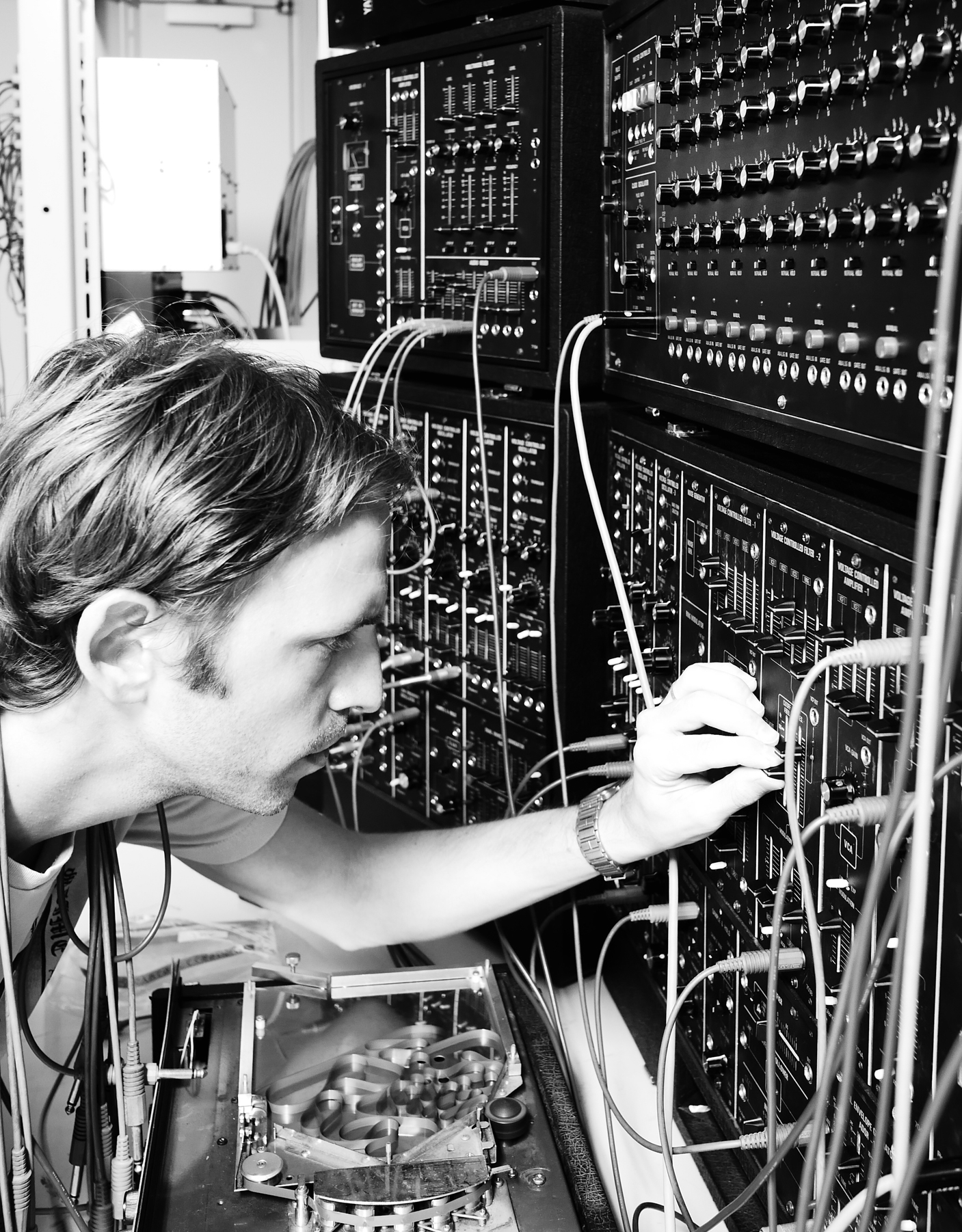
Agustín Spinetto / スピネット・アグスティン
Agustín Spinettoはアルゼンチン出身のミュージシャンで、母国で電子音楽の学士号を取得し、現在は東京芸術大学で音楽とサウンドクリエイションの修士号を取得しています。学部時代から電子楽器やアコースティック楽器を使い、新しい技術を使って音楽実験を行ってきた。シンセサイザーや音楽プログラミング言語を使った即興演奏に加え、ラップ、ヒップホップ、ジャズ、ノイズロックなどのポピュラーな音楽制作にも取り組む。現在は東京の後藤英教授の研究室に在籍し、アナログシンセサイザーを制御するための新しいインターフェースを研究テーマとしている。
電気音響音楽やライブ・エレクトロニクス・コンサートから、映像作家や造形作家とのコラボレーションによるアート・インスタレーションまで、幅広いスタイルで活動している。 アルゼンチン、ニューヨーク、東京のギャラリー、大学、会場でのライブ・プレゼンテーションも行っている。
Agustín Spinetto is an Argentinian musician, bachelor in Electronic Arts in his home country and currently doing his Master's Degree on Music and Sound Creation at the the Tokyo University of the arts. Since his time as undergraduate he has been working with electronic and acoustic music instruments and using new technologies for music experimentation purposes. His studies lead him to work with music improvisation with synthesizers and music programming languages, but also working with more popular music productions such us rap, hip hop, jazz and noise rock. Nowadays he is studying in Tokyo at Professor Suguru Goto department and his research theme is about new interfaces for controlling analogue synthesizers.
His performances cover a wide variety of styles, from Electroacoustic Music and Live Electronics concerts to Art Installations in collaboration with visual and plastic artists. He has done several live presentations at Galleries, Universities and venues in Argentina, New York and Tokyo. Nowadays, as a composer, he is experimenting with Audiostellar, a new cutting-edge music software based on audio-sample 2D space organization along with Max MSP programming and analogue synthesizers.
Title / タイトル
A short period of time and sound / 「時間と音の小品」
Performer / 出演者
A short period of time and sound / スピネット・アグスティン
“This is why we need to fix the bridge” 2.0
顧 昊倫 / Haolun GU
Program note / プログラムノート
「こんな大変なご時世に何ができるのか、と思う人は決して少なくないのだろう。家を出られれないことに確かに色々な制限はあったが、出られないおかげで世界中の人々がお互いに音楽からもらった喜びをシェアすることができるかもしれない。いわゆる、ライブストリーミングを介し、私たちの音楽は国境を越え、言葉を越え、架け橋であるように思われる。本作品では、きわめてシンプルな音素材を楽器として演奏し、ライブ・エレクトロニクスの形式で没入感を醸し出す。予め録音された鈴、ピアノ内部奏法、足音による打撃音、街の音、人の声などを加え、日常的な音から得る、人間の原始的共感を伝えていく。
It is thought to be necessary that think about what we can do during this hard time. Due to the lockdown of cities, and keep staying at home caused lots of limitation indeed. Or we can consider the whole thing on the other side, that this is the time perfectly for us to stay with music, and share all the delight which earned from music with all the people around the world. Through live streaming, our music is made to be a so-called bridge, crosses over nationality, language, etc. In this piece, extremely simple sound samples are used as instruments, engender an immersion experience through live electronics. With other prepared samples such as hammering sound like bell, inside piano, footsteps, street sound and voice, conveys primitive empathies of human beings.
Bio / 略歴

顧 昊倫 / Haolun GU
1994年11月中国・蘇州市生まれ。高校一年より作曲を学ぶ。
2017年上海音楽学院音楽デザインと制作科を最優等の成績で修了し、2020年東京藝術大学大学院音楽音響創造科修士課程を修了。作品は、NYCEMF、ICMCなどの電子音楽祭に入選され、各地で演奏されている。これまでに作曲を秦毅、尹明五、陳強斌、西岡龍彦、後藤英の各氏に師事。
Born in Nov. 1994, a native of Suzhou, China.
GU received his Bachelor’s degree from Shanghai Conservatory of Music in 2017, and completed his Master degree in Tokyo University of the Arts in 2020. His works have been commissioned and selected by international electronic music festivals such as NYCEMF, ICMC, and performed in multiple countries. He has studied composition with Yi Qin, Mingwu Yin, Qiangbin Chen, Tatsuhiko Nishioka, and Suguru Goto.
Title / タイトル
“This is why we need to fix the bridge” 2.0
Performer / 出演者
顧 昊倫
X-SynapseL―アルトリコーダーとライブエレクトロニクスのためのー
Leonid Zvolinsky
Program note / プログラムノート
「X-SynapseLーアルトリコーダーとライブエレクトロニクスのためのー」は、内部コミュニケーションと情報伝達の際に生じる歪み、そしてそのような変容が臨界量まで蓄積された結果に注目した作品です。元の意味を探求する試みは動きを生じさせ、かえって別の方向へ向かうことを避けられません。
冒頭に提示されるリズムの動き、アクセント、長い音の3つの要素が変化する中で曲が発展・変容し、徐々に混ざり合って新しい形式を形成していきます。エレクトロニクスのパートはフルートパートから生まれ、音楽的要素間でシナプスの神経回路に似た仕組みを創りながらフルートパートと相互に影響を与え合っていきます。
X-SynapseL for alto recorder and live electronics is a piece about internal communication, distortions in the transmission of information, as well as the consequences when a critical number of errors accumulate as a result of such transformations. The attempt to find the original meanings generates a movement that inevitably goes further and further away.
Bio / 略歴

Leonid Zvolinsky
ロシア、リャザン市生まれ。2014年モスクワ音楽院作曲科首席卒業、2015年リトフチンテレビ・ラジオ大学音響映像芸術サウンドプロデュース科修了。
2019年より東京藝術大学大学院音楽研究科(音楽音響創造)後藤英研究室の研究生。
Born in Ryazan (Russia), Leonid Zvolinskii graduated from the Composition Course of Moscow Conservatory in 2014, later he studied sound engineering and audiovisual arts at GITR film & television school in 2015. From 2019 to the present he is a research student of Goto Laboratory of Tokyo University of Arts.
Title / タイトル
X-SynapseL―アルトリコーダーとライブエレクトロニクスのためのー
Performer / 出演者
Leonid Zvolinsky
Enchanted I (2019-2020)
満潔 / Jie Man
Program note / プログラムノート
今回は人工知能と作曲という研究テーマにおいて作品制作を行った。Open Music、Max/Msp、Omax、Audio Sculptといったソフトウェアを使い、作曲プロセスの初期段階における音の構造、作品の構造と関連した自動生成システムや、作品の展開における音楽の自動生成システムを、作曲する過程で色々試してみた。モンゴル民族音楽の録音素材や日本で録音した音楽素材をAI技術と結びつけて作品の中で多様な響きを生み出すことによって、今回の研究テーマとこの作品のコンセプトを実現しようと試みした。
今回はMax/Mspを用いて映像を作ってみた。
This time I produced this work regarding on my research theme “Artificial intelligence and composition.” Using software such as Open Music, Max / Msp, Omax, and Audio Sculpt, I tried various ways in the process of composing music, such as process the structure of sound in the initial stage of the composition, the automatic generation system related to the structure of the work, and the automatic generation system of music in the development of the work. I intent to materialize this research theme and the concept of this work by combining Mongolian ethnic music recording materials and music materials recorded in Japan with AI technology and creating different sounds in the work. The video was made using Max / Msp.
Bio / 略歴

満潔 / Jie Man
内モンゴル大学芸術学院音楽科ピアノ専攻を卒業。同大学院音楽研究科修士課程音楽学 (作曲分野)を修了。2011年から日本留学。愛知県立芸術大学を経て、東京芸術大学大学院に入学。2014 年東京芸術大学大学院音楽研究科修士課程作曲専攻を修了。現在は同大 学院の音楽音響創造科博士後期課程に在学中。作品はアジアの管弦の現在3(2015)、Joint-WOCMAT-IRCAM Forum Conference(2016)、SICMF(2017)、SMC(2018、2019)、ICMC(2018、2019)などの国際音楽祭てで演奏している。 近年はコラボレーションのための音楽なとども手かがける。本とCDのための作品「痕跡」は東京藝術大学美術館賞 (2014)を受賞、作品所蔵。室内アンサンブル作品を中国国家芸術基金(2018、2019)に入選。これまでに作曲を李世相、郭偉国、山本裕之、中村典子、野平一郎、西岡龍彦、後藤英の各氏に師事。
Jie Man , Born in Inner Mongol, China. She graduated from Inner Mongol University Art Institute department of Music, speciality of Piano and received the master degree from the Graduate School of the same. She studied in Japan since 2011 and got her second master's degree in Composition from Tokyo University of Arts. She is currently pursuing a Ph.D. degree in composition for electro-acoustic & instrumental music. Her work has been collected by Tokyo University of Arts Museum, and she was invited from Contemporary Music Festival Present of Orchestral Asia 2015, her works were premiered in the 2016 International Workshop on Computer Music and Audio Technology (FORUM IRCAM-WOCMAT Taiwan 2016), Seoul International Computer Music Festival 2017, SMC2018 and 2019, ICMC2018 and 2019. Her music is regularly performed mainly in China and Japan. She studied composition with Li Shixiang, Guo Weiguo, Yamamoto Hiroyuki, Nakamura Noriko, Nodaira Ichiro, NISHIOKA Tatsuhiko, and Goto Suguru.
Title / タイトル
Enchanted I (2019-2020)
Performer / 出演者
満潔 / Jie Man
《非在の松風》尺八とコンピュータのための (2020)
/ "non-existent pine breeze" for a shakuhachi and computer (2020)
福島 諭 / Satoshi Fukushima
Program note / プログラムノート
《非在の松風》は尺八奏者とコンピュータのためのライブ・エレクトロニクス作品である。奏者の演奏をリアルタイムにサンプリング処理しながら楽曲全体を構成する。江戸時代後期の僧侶、良寛(りょうかん)が40代後半に移り住んだ五合庵(ごごうあん)は、現在の新潟県燕市の国上山に在る。良寛和尚は松林の谷に吹き抜ける松風に波の音を聴いた。
"non-existent pine breeze" is a live electronic work for shakuhachi player and computer. The piece was created while sampling and processing the player's performance in real time. Ryokan, a monk from the late Edo period, moved to Gogoan in his late 40s, where he lived in the It is located on Kunigami Mountain in Tsubame City, Niigata Prefecture. Ryokan heard the sound of waves in the pine breeze blowing through the valley of the pine forest.
Bio / 略歴
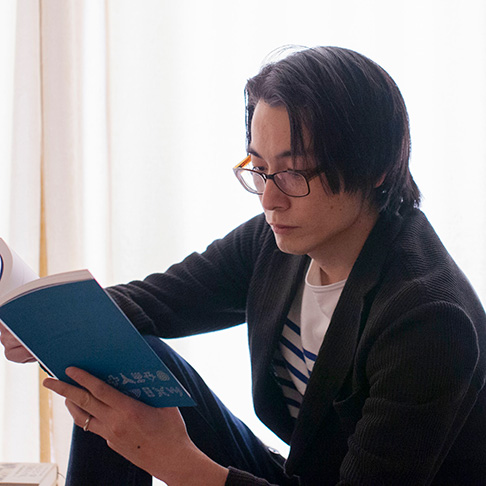
福島 諭 / Satoshi Fukushima
1977年新潟生まれ。作曲家。IAMAS ( 岐阜県立情報科学芸術大学院大学 ) 修了。
2002年よりリアルタイムなコンピューター処理と演奏者との対話的な関係によって成立する作曲作品を発表。また、Mimiz、gpのメンバー。
2008年より濱地潤一氏との室内楽シリーズの作曲を積極的に開始する。なかでも交換型共同作曲作品《変容の対象》は2009年元旦より開始されこれまでに130曲以上が作曲され現在も進行中である。
これまでの主な作曲作品は自身によって詳細な作曲方法の解説と共に独自の楽譜に残されてきており、時間の中で展開される現象とその記録方法についての考察を続けている。
2016年G.F.G.SレーベルよりCD「福島諭:室内楽2011-2015」をリリース。
日本電子音楽協会理事(2017年度-)。作曲を三輪眞弘氏に師事。
[主な賞歴]
2006年 第一回 AACサウンドパフォーマンス道場 優秀賞
2011年 第六回 JFC作曲賞 入選
2014年 第十八回文化庁メディア芸術祭 アート部門 優秀賞
2017年 「坂本龍一|設置音楽コンテスト」佳作
He was born in 1977. Japanese composer.
He graduated from Niigata University's Faculty of Education, where he was trained to teach special subjects (music).
He received his M.F.A. in Media Expression from the Institute of Advanced Media Arts andSciences (IAMAS).
Since 2002, he has been creating compositions based on real-time computer processing and interactive relationships with performers.
He is also a member of the band Mimiz, which experiments with improvisation and computer-based sessions of its own.
In 2008, he began to actively compose chamber music series with Junichi Hamaji. Among them, "an object of metamorphose", an exchange-type collaborative composition, was started on New Year's Day 2009 and is still in progress.
Some of his previous compositions have been written by himself in his own score with detailed commentary and formatting. He continues to reflect on the description of time and how it is played.
The CD "Satoshi Fukushima: Chamber Music 2011-2015" was released on G.F.G.S. label in 2016.
He is a member of the Japan Electronic Music Association. Studied composition under Masahiro Miwa.
url: www.shimaf.com
Some of the major awards he's been associated with are
Mimiz: 2006 ARS ELECTRONICA 2006 Digital Music Honorary Mention
Satoshi Fukushima: 2006 The First AAC Sound Performance Dojo Award for Excellence
Satoshi Fukushima: The 6th JFC Composition Award 2011, Honorable Mention
Junichi Hamaji + Satoshi Fukushima: The 17th Japan Media Arts Festival 2013, Art Division, Jury Recommended Work
Satoshi Fukushima: 2014 Japan Media Arts Festival, Excellence Award, Art Division
Satoshi Fukushima: Honorable mention in the 2017 Ryuichi Sakamoto Installation Music Contest
Title / タイトル
《非在の松風》尺八とコンピュータのための (2020) / "non-existent pine breeze" for a shakuhachi and computer (2020)
Performer / 出演者

尺八奏者: 福島麗秋
1948年生まれ。群馬県出身。新潟大学人文学部(法)卒。教職の道を進む。佐渡勤務の折、村松流尺八に出会う。その後、都山流尺八を学び准師範免状を取得、現在に至る。
Shakuhachi by Reisyu Fukushima
Born in Gunma Prefecture in 1948. Graduated from the Faculty of Humanities (Law) at Niigata University. Worked as a teacher. Encountered the Muramatsu school of shakuhachi while working on Sado Island. Later, he studied the Tozan-ryu shakuhachi and obtained an associate teacher's license.
「虹機械」はじまりのうた
/ "Rainbow Machine" The Genesis of Chant
三輪 眞弘 / Masahiro Miwa
Program note / プログラムノート
“「虹機械」はじまりのうた”は、第9回浜松国際ピアノコンクール(2015年)の第2次予選課題曲として作曲された。
同年に作曲された、“「虹機械」公案-001”と同様、五度音程の積み重ねを基本原理とするセルフフィードバック・システムによって自動生成される単旋律はその過程において音域や調性の明瞭度などを変化させながら刻々と音楽的「気分」を変えていく。しかしその「気分」の起源は、変化を続ける音型パターンに対して繊細に、そして「機械のように」反応するしかないぼくたち人間の側にあることは言うまでもない。
"Rainbow Machine" The Genesis of Chant was commissioned by the 9th Hamamatsu International Piano Competition held in 2015.
Same as the "Rainbow Machine Koan-001", which is composed in the same year, monophonic melody which is generated by a self-feedback system on the principle of stack of interval fifth is constantly changing its musical “feeling” through changing ranges and clarity of tonality. Needless to say, however, that the “feeling” comes from our (human) side, who cannot help sensitively and “mechanically” react to the changing sound pattern.
Bio / 略歴
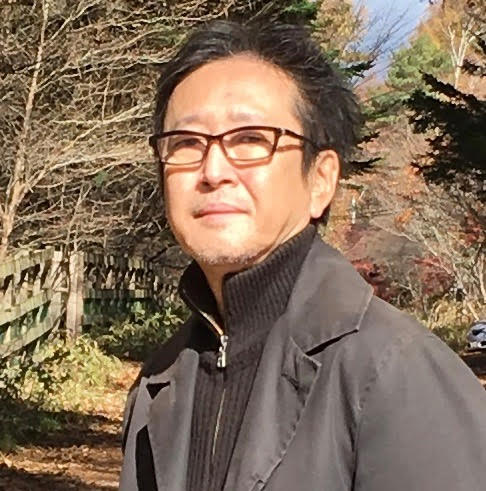
三輪 眞弘 / Masahiro Miwa
1958年東京に生まれる。ベルリン芸術大学、ロベルト・シューマン音楽大学で作曲を学ぶ。2004年芥川作曲賞、2007年プリ・アルスエレクトロニカでグランプリ(ゴールデン・ニカ)、2010年芸術選奨文部科学大臣賞などを受賞。「三輪眞弘音楽藝術 全思考一九九八ー二〇一〇」をはじめ、CD「村松ギヤ(春の祭典)」や楽譜出版など多数。旧「方法主義」同人。「フォルマント兄弟」の兄。情報科学芸術大学院大学[IAMAS]教授。
https://www.iamas.ac.jp/~mmiwa/ToDo.html
Masahiro Miwa, born in 1958, is a Japanese composer.
Studied composition at the Berlin University of the Arts and the Robert Schumann Hochschule. He is currently a professor at the Institute of Advanced Media Arts and Sciences (IAMAS). He has composed many works by the algorithmic composition method on computer. Among his compositions are the opera The New Era and the orchestral piece Bolero by Muramatsu Gear Engine.
Recent publications include Miwa Masahiro Ongaku Geijutsu -- Zenshiko 1998-2010 (The Musical Art of Miwa Masahiro: Complete Thoughts 1998-2010; Artes Publishing, 2010) and the CD Muramatsu Gear (Le Sacre du Printemps; 2012).
Miwa has been the recipient of many awards for his work, including: the Hambacher Prize (Germany, 1985); the Irino Prize (Japan, 1989); second prize in the Music Today Composition Contest (Japan, 1991); first prize in the Concorso Internationale Luigi Russoro (Italy, 1992); the Muramatsu Award (Japan, 1995); the Akutagawa Award for Music Composition (Japan, 2004) and Prix Ars Electronica (Golden Nica) in Digital Musics & Sound Arts (2007 Austria).
He is also active in events and lectures as a member of the composition cooperative Formant Brothers.
https://www.iamas.ac.jp/~mmiwa/ToDo.html
Title / タイトル
「虹機械」はじまりのうた / "Rainbow Machine" The Genesis of Chant
Performer / 出演者

ピアノ: 山内敦子
愛知県立明和高等学校音楽科を卒業後渡仏し、パリ・エコールノルマル音楽院を修了。帰国後、愛知県立芸術大学音楽学部卒業。名古屋音楽大学大学院修士課程修了。第4回ノーヴィ国際音楽コンクール第1位。第5回チェコ音楽コンクール第1位。2011年より毎年リサイタルを開催。メディアアート作品、エレクトロニクスや照明、映像作家、ダンサー、俳優との共演公演なども多く、また、フジテレビ「全力!脱力タイムズ」、メーテレ「癒しの存在」などメディアや映画、映像作品への出演・演奏も行っている。コンサートグループ「花の詩」、名古屋フランス音楽研究会会員。現在、岡崎女子大学、岡崎女子短期大学、中部大学、大同大学各非常勤講師。
Piano: Atsuko Yamauchi
Atsuko Yamauchi, a native of Nagoya, Japan, is a pianist who has been actively performing and teaching in multiple fields. After graduating from the music course program at Meiwa High School in Nagoya, Japan, she relocated to France where she attained her diploma from École Normale de Musique de Paris. After returning to Japan in 2002, she graduated from Aichi University of the Arts and Music and holds a master’s degree from Nagoya College of Music.She won first prizes at the 4th NOVYI International Music Competition and the 5th Česká Hudební Soutěž. She has been holding her own recitals annually since 2011 and has also been collaborating with filmmakers, dancers, and actors, while integrating her work with various media arts, electronics, and lighting. She made appearances on TV programs such as “Zenryoku! Datsuryoku Times” by Fuji Television and “Iyashi No Sonzai” by Nagoya Broadcasting Network. Atsuko is a member of the performance group Hana No Uta and Association des Amis de la musique Française de Nagoya. She not only works as a pianist, but also dedicates her time to teaching the next generations at Okazaki Women’s University/Junior College, Chubu University, and Daido University.
AI ベートーベン
/ AI Beethoven
Suguru Goto / 後藤英
Direction, Concept / ディレクション、コンセプト
Toru Yokoyama / 横山徹
Images / 映像
Shinae Kang / 姜信愛
Music Machine Learning / ミュージック・マシーン・ラーニング
Tei U / 鄭瑀
Music Machine Learning / ミュージック・マシーン・ラーニング
Can Li / Can Li
Face Recognition Machine Learning / フェイスレコグニション・マシンラーニング
Program note / プログラムノート
この作品はベートーベンの生誕250周年のためのイベントより委嘱された。構想としてはベートーベンを現代に蘇させるという試みがされた。つまりAIを用いてベートーベンを再現させようとするものである。
ベートーベンの「エリーゼのために」は誰もが聞いたことのあるピアノ曲であろう。1810年、ベートーベンが40歳の時に、エリーゼという女性に恋をして、「エリーゼのために」を作曲したと言われている。
1827年に死去したベートーベンが約200 年後の2020年に蘇って、現代の日本人女性に恋をしたらどのような「エリーゼのために」を作曲するだろうか?そこで、この作品では、特に一般の女性に参加してもらうことにより成り立つ。顔認識のAIにより、その人物の魅力度や年齢などが分析され、そのデータをもとにベートーベンが恋をして、さらに音楽のAIにより作曲をする。そのAIとは、中心的な役割を果たす「エリーゼのために」とその他のベートーベンのピアノ曲を学習して、ベートーベン風のピアノ曲を自動作曲する。
This work was commissioned from an event for Beethoven's 250th birthday. As a concept, an attempt was made to bring Beethoven back to life. In other words, AI is used to reproduce Beethoven.
"For Elise" by Beethoven's is one of well-known piano piece that everyone has previously listened to. In 1810, when Beethoven was at age of 40, he fell in love with a woman named Elise and composed "for Elise" for her.
What if Beethoven, who died in 1827, revived in 2020, about 200 years later and how "for Elise" would be composed again, if Beethoven fell in love with a modern Japanese woman? Therefore, in this work, we call a woman from a public to participate in this performance. The face recognition AI analyzes the attractiveness and age of the person etc., and based on this data, Beethoven falls in love this woman, and composes with the music AI. This AI mainly learns “For Elise” and other Beethoven piano pieces that play, and then automatically compose Beethoven-like piano pieces.
Bio / 略歴
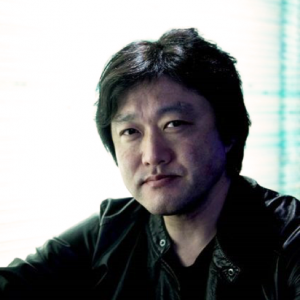
後藤 英 / Suguru Goto
作曲家、ニューメディア・アーティスト。国際的に評価されており世界活地で活躍。刺激的な作品で新たなテクノロジーと関連させて発表している。フランス、パリにあるポンピドゥー・センターのIRCAMの招待作曲家、研究員、ボルドー芸術大学の准教授を経て、現在は東京芸術大学の准教授。
主な賞歴は、ボストン・シンフォニー・オーケストラ・フェローシップ、タングルウッド音楽祭より、クーセヴィツキー賞、ワシントン州のマルゼナ国際作曲コンペティションにて第1位、ドイツにてベルリナー・コンポジション・アウフトラーゲ1994、パリのユネスコで行われた、IMC国際作曲家会議にて入選、フランス政府よりDICREAM、ドイツ、ベルリンのミュージック・シアター・ナウ・アワード2008にて受賞、フランス、バン・ニューメリック4、アンガン・デ・バン・デジタル・アート国際フェスティバルにて、「OFQJダンス・ニューテクノロジー賞」を受賞、2010年ブラジルのFileフェスティバルにてFILE PRIX LUXのElectronic Sonority Honor Award 賞、2011年イタリアにてAction Sharing 2の大賞を受賞、2013年KAO国際キネティック・アート・コンペティションにて第2位、同年オーストリアのアルスエレクトニカにてデジタル・ミュージック&サウンド・アートの栄誉賞を受賞などが挙げられる。作品は世界各国の音楽祭、レゾナンス/IRCAM、タングルウッド音楽祭、ICC、SONAR、 Haus der Kultures der Welt, ISEA、NIME, ヴェネツィアビエンナーレなどにて演奏されている。
“A journey to the boundaries of sound with human sensitivity. This is the near future, between science fiction and reality, towards which Suguru Goto, a leading exponent of the new generation of Japanese experimental artist that has made an important contribution to the world.”
From the catalog of Venice Biennale 2009
“The speed of the technological evolution is another challenge. When the artist will have explored an interactive phenomenon, developed an idea of performance, and surmounted all technological obstacles, the invention may already be superseded by a new process. It is surprising to see Japanese Suguro Goto offer a room with this direct link.”
From the magazine « Dancer » (2009.9) in France
Suguru Goto is a media artist, an inventor and a performer and he is considered one of the most innovative and the mouthpiece of a new generation of Japanese artists. He is highly connected to technical experimentation in the artistic field and to the extension of the existing potentialities in the relation man-machine. In his works the new technologies mix up in interactive installations and experimental performances; he is the one who invented the so called virtual music instruments, able to create an interface for the communication between human movements and the computer, where sound and video image are controlled by virtual music instruments in real-time through computers.
He has been internationally active and has received numerous prizes and fellowships, such as Koussevitzky Prize, BSO fellowships, the first prize at the Marzena, Berliner Kompositionaufträge, a prize by the IMC International Rostrum of Composers in UNESCO, Paris, DIRECAM, French Cultural Minister, Music Theater Award 2008 in Berlin, "OFQJ-dance and new technology prize" at Bains Numérique #4, International Festival of digital art of Enghein-Les-Bains, in France, in 2009, Electronic Sonority Honor Award Prize, FILE PRIX LUX, in Brazil, in 2010, the winner of the Action Sharing 2, in Italy, in 2011, the 2nd prize in the 2013 KAO International Kinetic Art Competition, Prix Ars Electronica 2013 Digital Musics & Sound Art | Honorary Mention and so on. His works have been performed in major festivals, such as Resonaces/IRCAM, Sonar, ICC, Haus der Kultures der Welt, ISEA, NIME, AV Festival, STRP Festival 2009, Venice Biennale, etc.
In 2016, his book “Emprise” is published from StyleNote publishing, in Tokyo. At the same year, his CD “CsO” is published from Athor Harmonics, in Tokyo.
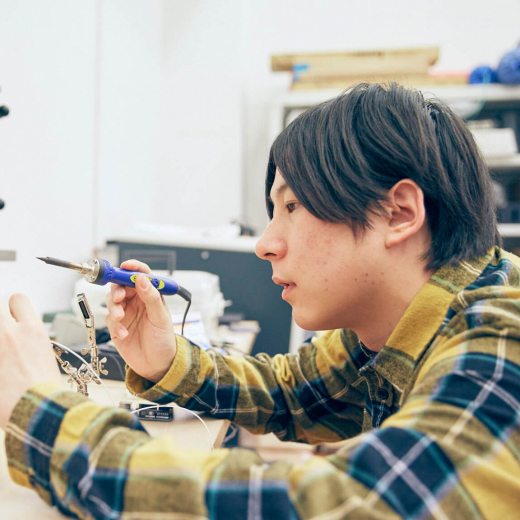
横山徹 / Toru Yokoyama
1983年 福岡県生まれ。情報科学芸術大学院大学(IAMAS)卒業。
銀塩時代からの写真史の流れを参照しつつデジタル・テクノロジーのみで可能な写真表現の新しいあり方を研究している。
また、並行してプログラミングを駆使したマルチメディア表現・リアルタイム3D表現をベースにインスタレーションを制作している。
近年参加した展覧会に「RGB」(2015年/the newly / Mister Hollywood OSAKA)、「Media Ambition Tokyo」(2016年/東京)、「ウィリアムクライン たしかな心と眼」(2017年/東京)「Jerusalem Design Week」(2019年/イスラエル)など。
2018年から建築、写真、グラフィック、プログラム等のバックグラウンドを持つメンバーから成るデザイングループv0idのメンバーとしても活動している。
FIGLAB/amana inc.所属 東京藝術大学音楽学部非常勤講師
TokyoTDC2020 入賞
Spikes Asia 2019 | Film Craft - SILVER, BRONZE
CICLOPE Festival 2019 | Music Video - FINALIST
AD STARS 2019 | Film Craft - CRYSTAL, Music Video - CRYSTAL
ONE SCREEN Short Film Festival 2018 | Music Video - FINALIST
New York Festivals TV & Film Awards 2020 | Craft: Program - GOLD Streaming – GOLD
Born in 1983 in Fukuoka, Japan. Graduated from Institute of Advanced Media Arts and Sciences (IAMAS).
While referring to the history of photography since the silver halide era, and researching new ways of photographic expression that are possible only with digital technology.
At the same time, he creates installations based on multimedia and real-time 3D expressions that make full use of programming.
Recent exhibitions he has participated in include "RGB" (2015, the newly / Mister Hollywood OSAKA), "Media Ambition Tokyo" (2016, Tokyo), "William Klein: A Certain Mind and Eye" (2017, Tokyo) and "Jerusalem Design Week" (2019, Israel),and more.
Since 2018, Toru Yokoyama has also been a member of "v0id", a design group consisting of members with backgrounds in architecture, photography, graphics and programming.
Belongs to FIGLAB/amana inc. Part-time lecturer at Tokyo University of the Arts, Faculty of Music
TokyoTDC2020 winning a prize
Spikes Asia 2019 | Film Craft - SILVER, BRONZE
CICLOPE Festival 2019 | Music Video - FINALIST
AD STARS 2019 | Film Craft - CRYSTAL, Music Video - CRYSTAL
ONE SCREEN Short Film Festival 2018 | Music Video - FINALIST
New York Festivals TV & Film Awards 2020 | Craft: Program - GOLD Streaming – GOLD
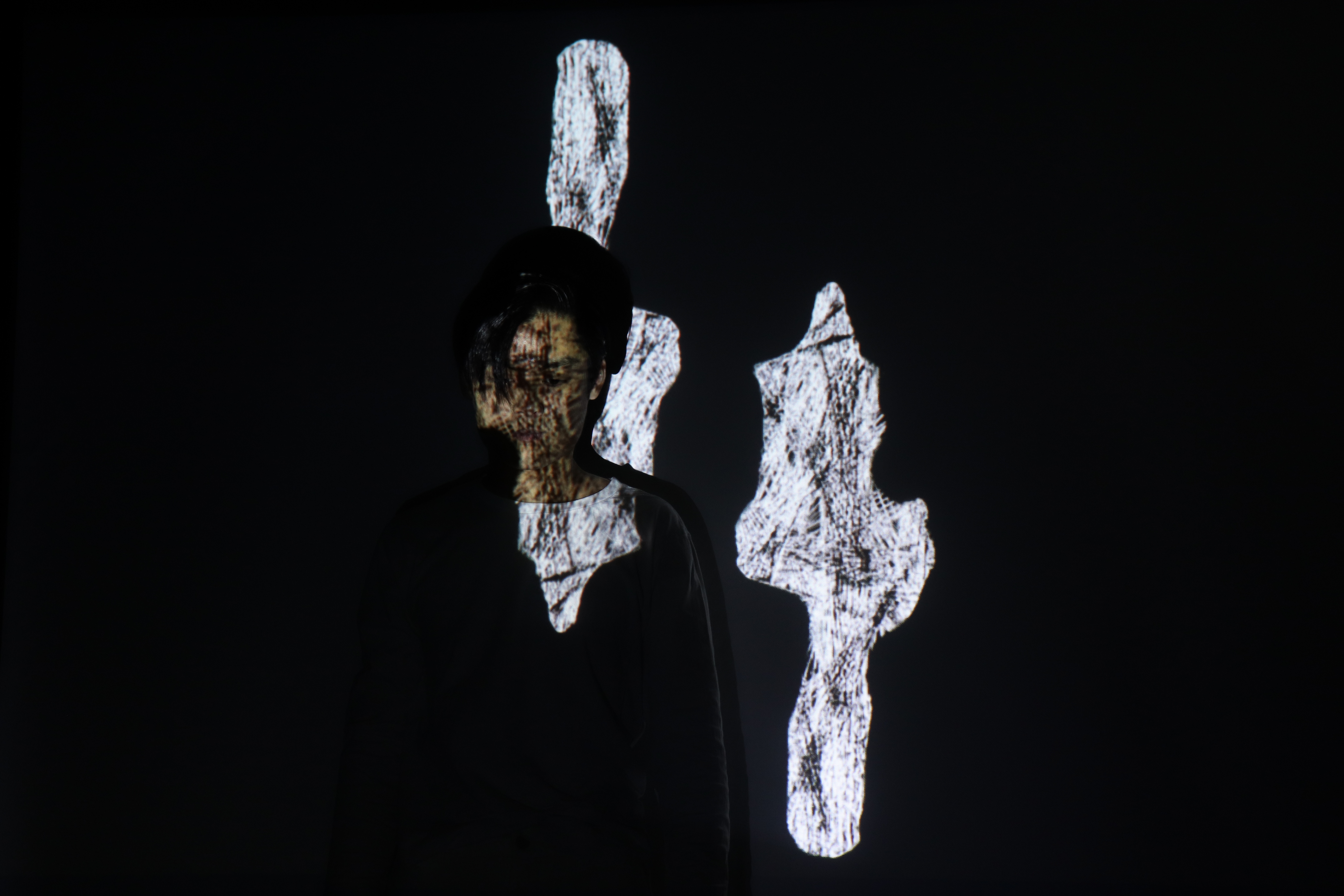
鄭瑀 / TEi U
中国福建省生まれ。2019年から研究生として後藤研究室に所属。
モーションキャプチャを用い、インタラクティブ音楽作品を研究している。現在、SNSを介して現実社会の様相に反映される創作の研究も行っている。これまでに作曲を梶本芳孝、香取良彦、森威功、後藤英の各氏に師事。
国際コンピュータ音楽会議(ICMC 2020) 入選
Born in Fujian, China, U Tei has been a research student of Goto’s Laboratory at Music and Sound Creation department since 2019, where he has been working on music composition using motion capture. Through his career he has been studying composition with Yoshitaka Kajimoto, Yoshihiko Katori, Takeyoshi Mori, and Suguru Goto.
Nowadays, his research is focus on how to create works that reflect social phenomena through SNS.
His last work, Plankton, was selected to participate at the International Computer Music Conference (ICMC 2020)
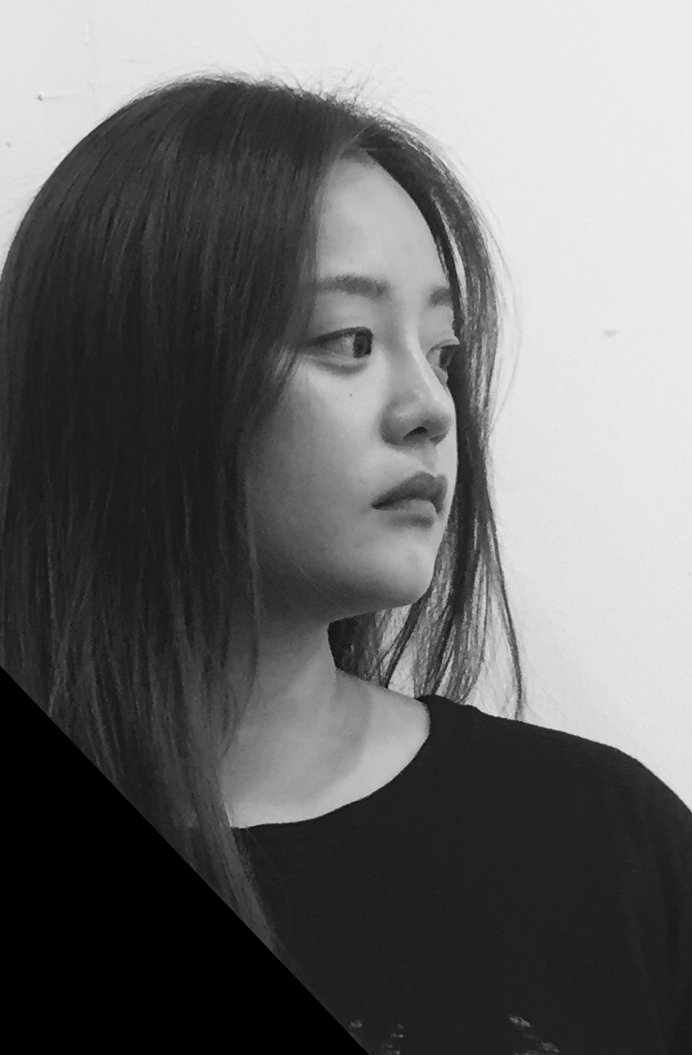
姜 信愛 / Shinae Kang
韓国生まれ。武蔵野音楽大学において飯島英嗣氏のもとで作曲を学ぶ。
Dongguk University (SEOUL,KOREA)GRADUATE SCHOOL OF DIGITAL IMAGE AND CONTENTSにおいてコンピューター音楽をJUN KIM氏に師事。作曲家、メディアアーティスト、映像音楽など幅広く活躍している。現在、東京芸術大学音楽学部博士課程において後藤英氏に師事。
Shine Kang is a composer and multimedia artist, currently studying computer music with prof. Goto Suguru as a Ph.D. student at Tokyo University of the Arts. She holds a Bachelor of Music degree in music composition from Musashino Academia Musicae and a Masters's degree in electronic music composition from Dongguk University. She endeavors to show new aspects of music by merging computer music with other modern genres. She tries to accommodate new technology into music in her recent works, such as composition applying artificial intelligence theory, and algorithmic composition and audiovisual art.
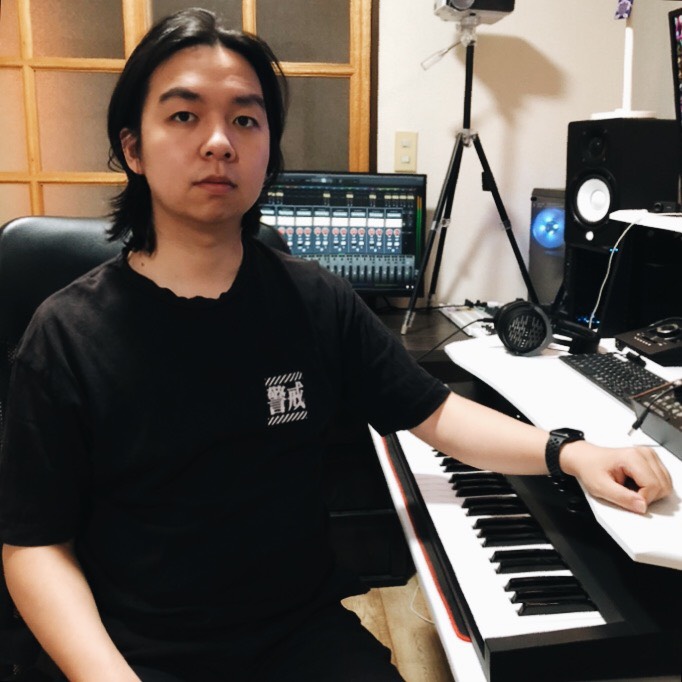
李 瓊宇 / Qiongyu Li
中国江蘇省生まれ。2018年から東京芸術大学音楽学部の研究生として後藤研究室に所属。センサー、IoTを用い、インターフェースデザイン、インタラクティブ ミュージック インスタレーションについて研究を行っている。現在、後藤研究室に所属しながら洗足学園音楽大学修士課程において森威功に師事。
Born in Jiangsu, China. he has been a research student of Goto's Laboratory at Music and Sound Creation department since 2018. He is focus on interface design and interactive music installations using sensors and IoT. He is currently studying under Takeshi Mori in the Master's program at Senzoku Gakuen Music University.
Title / タイトル
AI ベートーベン / AI Beethoven
Improvisation with Laptop 2020
有馬 純寿 / Sumihisa Arima
Program note / プログラムノート
昨年のコンサートに引き続き、Maxを使用した即興演奏を行います。
今年度の上級コースの第1回で紹介するサードパーティのエクスターナルオブジェクトを使用したパッチを使用します。
I will improvise using Max like last year.
Use the patch using the external object that I will introduce on the first day of the advanced course.
Bio / 略歴
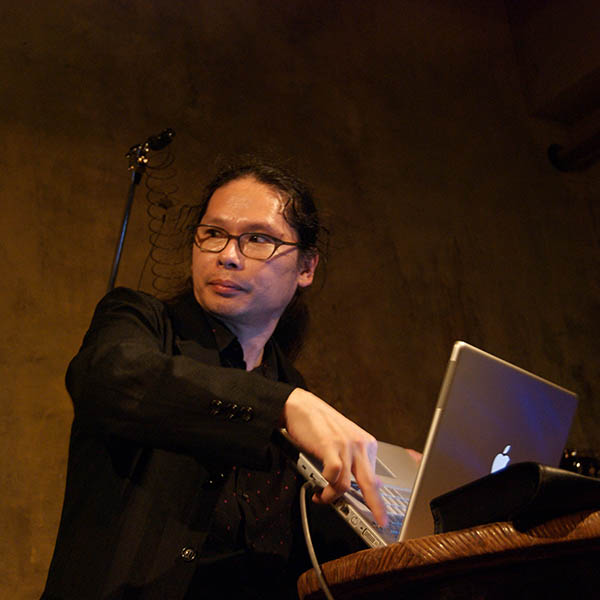
Photo: Saya Nishida
有馬 純寿 / Sumihisa Arima
1965年生まれ。エレクトロニクスやコンピュータを用いた音響表現を中心に、現代音楽、即興演奏などジャンルを横断する活動を展開。ソリストや室内アンサンブルのメンバーとして数多くの現代音楽の演奏会で電子音響の演奏や音響技術を手がけ高い評価を得ている。第63回芸術選奨文部科学大臣新人賞芸術振興部門受賞。2012年より国内外の現代音楽シーンで活躍する演奏家たちとアンサンブル「東京現音計画」を開始、第1回公演が第13回佐治敬三賞を受賞。また実験的な音楽家とのセッションや美術家とのコラボレーションも多い。現在、帝塚山学院大学人間科学部准教授。京都市立芸術大学非常勤講師。
Maxを使いだして早30年、最初のヴァージョンは2.1.2。
Born in 1965. Developed wide ranged activities including noise music, electronica and the Contemporary music utilizing the computer and electronics, performs both in Japan and Europe. His ways of presentations are also diversified such as sound installations, live performances and CD releases.
Title / タイトル
Improvisation with Laptop 2020
Performer / 出演者
有馬 純寿 / Sumihisa Arima